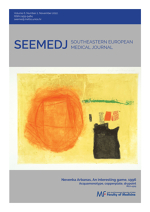Fractionation of Vipera berus berus Snake Venom and Detection of Bioactive Compounds Targeted to Blood Coagulation System
DOI:
https://doi.org/10.26332/seemedj.v6i2.256Ključne riječi:
snake venoms;, blood coagulation; , fibrinogen;, hemolysis; , platelet aggregationSažetak
Introduction. The performed research focused on a search for new biologically active compounds acting on blood coagulation system proteins and cells. To achieve this goal, we fractionated Vipera berus berus snake venom and studied the action of the separated fractions on human blood plasma, fibrinogen, platelets or red cells.
Methods. Crude venom was fractionated using ion-exchange chromatography. Protein composition of fractions was studied using SDS-PAGE. The ability of fractions to prolong or initiate blood plasma clotting was studied using the prothrombin time test with thromboplastin. Fibrinogen-specific proteases were detected using enzyme-electrophoresis. Action on red cells was estimated using the hemolysis test. Aggregometry was used for the detection of action on platelets. All experiments in this study were performed in vitro.
Results. We obtained fractions containing phospholipase and a protease that is able to hydrolyze fibrinogen, leading to the loss of its ability to polymerize and to maintain platelet aggregation.
Conclusion. Further purification and study of these components can be a promising research direction for biotechnological as well as for biomedical use.
Preuzimanja
Objavljeno
Broj časopisa
Rubrika
Licenca
Autorska prava (c) 2025 Southeastern European Medical Journal

This work is licensed under a Kreativni Commons Attribution-NonCommercial-NoDerivatives 4.0 International License.



